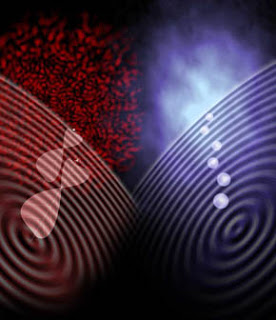Artist’s impression of the speckle pattern created by a multimode light beam (top, red), and the image measured in this experiment created by a multimode beam of atoms (top, blue). Source: Dr Tim Wetherell, ANU
The researchers’ work has implications for future quantum devices that require smoothly-guided matter waves, such as atom interferometers which need to sensitively measure the earth’s gravitational field for geo-exploration. T
Experimental schematic – A thermal cloud/Bose–Einstein condensate (BEC) is confined in an optical trap, produced by a single focused laser beam in the vertical direction. By reducing the power in the optical beam, the cloud is no longer supported against gravity
Speckle patterns produced by multiple independent light sources are a manifestation of the coherence of the light field. Second-order correlations exhibited in phenomena such as photon bunching, termed the Hanbury Brown–Twiss effect, are a measure of quantum coherence. Here we observe for the first time atomic speckle produced by atoms transmitted through an optical waveguide, and link this to second-order correlations of the atomic arrival times. We show that multimode matter-wave guiding, which is directly analogous to multimode light guiding in optical fibres, produces a speckled transverse intensity pattern and atom bunching, whereas single-mode guiding of atoms that are output-coupled from a Bose–Einstein condensate yields a smooth intensity profile and a second-order correlation value of unity. Both first- and second-order coherence are important for applications requiring a fully coherent atomic source, such as squeezed-atom interferometry.
Multimode speckle images – (a–c) Successive experimental realizations produced by guiding only the thermal component of the trapped atoms, showing interference between the thermal modes (‘speckle’). Each panel (a–c) is a single experimental run
“In an optical fibre, many modes of light can be conducted simultaneously, and they can interfere to produce a speckled pattern of light,” said team member Professor Ken Baldwin from the ARC Centre of Excellence for Quantum-Atom Optics at ANU.
“We have shown that when atoms in a vacuum chamber are guided inside a laser light beam, they too can create a speckle pattern – an image of which we have captured for the first time”.
The team trapped a cloud of cold helium atoms at the focus of an intense laser beam pointed downwards at the imaging system, and then gradually turned down the laser intensity until the speckled image appeared. The work was done with PhD students Sean Hodgman and Andrew Manning.
“We then made the atoms even colder,” says team leader Dr Andrew Truscott, “until they behaved more like waves than particles, forming a single quantum wave called a Bose-Einstein condensate (BEC). When the BEC was loaded into the guide, the speckle pattern disappeared, showing that just one mode was being transmitted – the single quantum wave.”
The physicists demonstrated that by measuring the arrival time of the atoms on the imaging system, they were able to distinguish between the multimode (speckled image) guiding, and the single-mode (smooth image) guiding.
“Measurements for the multi-mode beam showed the atoms arriving in groups as a result of their interference – so-called atom bunching,” said team member Dr Robert Dall. “However, the BEC represents just a single quantum mode with no interference, so when we guided the BEC – we saw no bunching.”
The guiding behaviour agreed with a theoretical model developed by team member Mattias Johnsson. “We have shown that atoms can be guided in a laser beam of light, with the same properties as light guided in an optical fibre made of glass,” said Dr Johnsson.
If you liked this article, please give it a quick review on ycombinator or StumbleUpon. Thanks

Brian Wang is a Futurist Thought Leader and a popular Science blogger with 1 million readers per month. His blog Nextbigfuture.com is ranked #1 Science News Blog. It covers many disruptive technology and trends including Space, Robotics, Artificial Intelligence, Medicine, Anti-aging Biotechnology, and Nanotechnology.
Known for identifying cutting edge technologies, he is currently a Co-Founder of a startup and fundraiser for high potential early-stage companies. He is the Head of Research for Allocations for deep technology investments and an Angel Investor at Space Angels.
A frequent speaker at corporations, he has been a TEDx speaker, a Singularity University speaker and guest at numerous interviews for radio and podcasts. He is open to public speaking and advising engagements.




